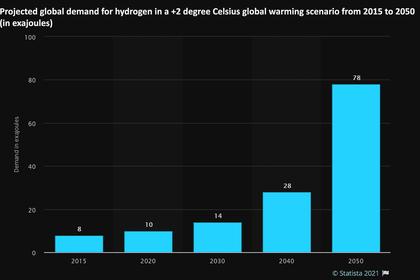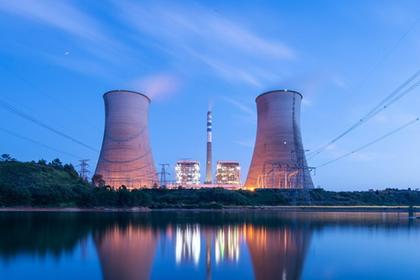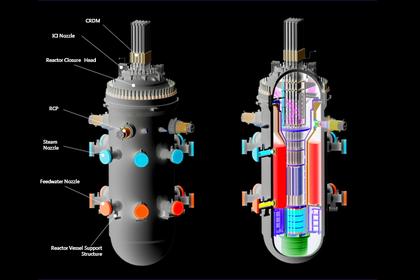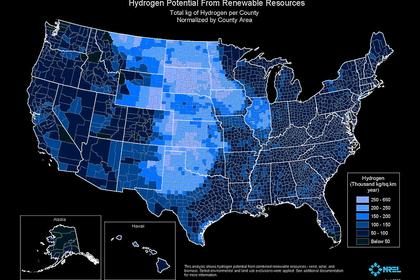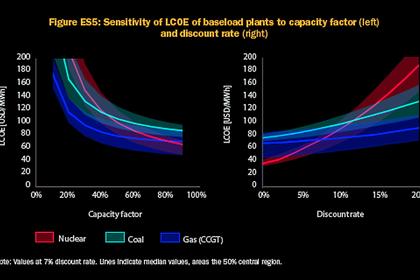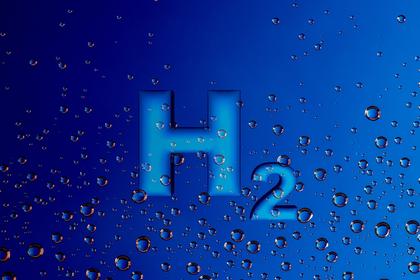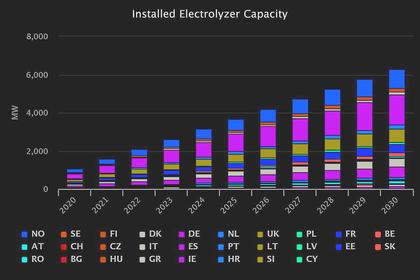
NUCLEAR + HYDROGEN ENERGY
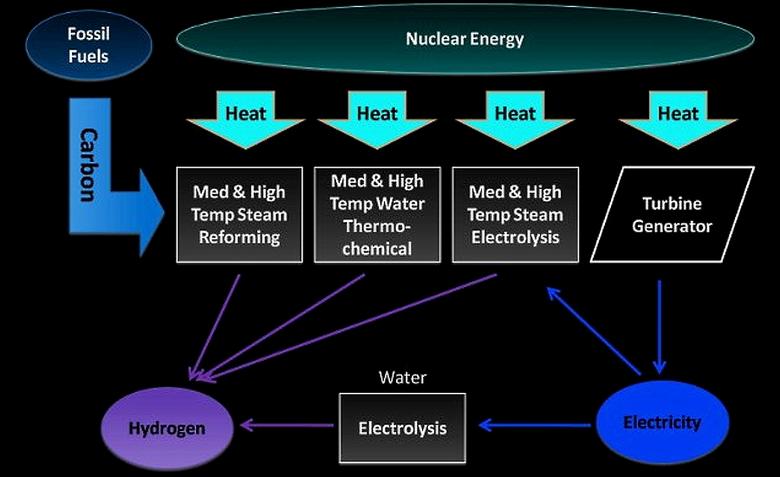
WNN - 26 January 2021 - Using nuclear plants to generate heat as well as electricity for non-grid industrial applications could be central to deep decarbonisation efforts beyond being a source of zero-carbon electricity. Speakers at the fifth Atlantic Council Global Energy Forum last week looked at how hydrogen - and nuclear - can contribute to carbon abatement efforts in areas that have so far been hard to decarbonise.
The session on Nuclear Beyond Power: Hydrogen, Heat, and Desalination focused on the opportunities for light-water-cooled and high temperature gas-cooled reactor designs to support the heat and electricity demands of industrial processes, hydrogen production and desalination to produce potable water. The session was moderated by Shannon Bragg-Sitton, lead for Integrated Energy Systems at the Idaho National Laboratory.
Recent studies have indicated that without nuclear energy the cost associated with achieving the ambitious decarbonisation targets set out in the 2015 Paris Agreement will increase significantly, Bragg-Sitton said. The primary heat output from nuclear is traditionally converted into electricity and supplied to the grid, but that primary heat can also be used to meet the demands of industry, or to produce process intermediates like hydrogen that can be used to produce consumer products, such as transport fuels. Using heat directly and leveraging energy at a time when it may not be needed to meet grid demands could also provide nuclear plants with an additional revenue stream, supporting their long-term economic viability, she said.
Current projections show the world is not on track to meet its goals under the Paris accord, said Kirsty Gogan, managing partner of research and consultancy firm Lucid Catalyst which last year published a report setting out how clean hydrogen can help correct this.
"Large-scale, low-cost hydrogen is the key ingredient that can enable the production of clean substitute fuels that can enable decarbonisation of those really tough-to-abate sectors like aviation, shipping, cement production, and industry," she said. However, to achieve this hydrogen needs to be cheap and competitive. "We estimate that the target price for hydrogen is around 90 [US] cents per kg. Current projections for renewables-generated hydrogen don't expect to achieve those costs until around 2050."
Existing nuclear technology could already produce hydrogen at below USD2 per kg, and a new generation of advanced small modular reactors could achieve the 90 cents per kg target price potentially by 2030, she said.
Nuclear's attributes - its production of low-cost power and heat combined with high capacity factors and a small land use footprint - make it well suited to enable the highly efficient and low-cost production of hydrogen, at a scale large enough to be relevant to global oil supply, which is currently around 100 million barrels per day, Gogan said.
To drive such a massive increase in clean hydrogen production will necessitate the transformation of project delivery and deployment models requiring the same intensity of focus seen in the development of renewables, she said. Near-term cost reductions could be achievable through a shift from a traditional construction-based approach to a high-productivity product-based approach. Existing manufacturing capacity and infrastructure - such as shipyards that have high manufacturing capacity and can produce designed-for-purpose offshore production platforms - could be tailored to hydrogen production. Production of substitute fuels could enable a new business model for oil and gas sectors, opening an entirely new business opportunity, with the oil sector continuing to leverage its existing industrial capabilities, she said.
"We could really accelerate deep decarbonisation across parts of our economy which frankly right now we do not have good answers for. By 2050 we could see low-cost clean hydrogen help to avoid really substantial global cumulative future carbon emissions from a very large fraction of otherwise locked-in fossil fuels," she said.
The role of nuclear technology
During the next few decades, nuclear reactors will be the most feasible source of the high temperatures needed to produce hydrogen most effectively, Seth Grae, president and CEO of advanced nuclear fuel developer Lightbridge Corporation, said. High temperature reactors can be commercialised to produce this but we need to start with current reactor technology, he said. "We can boost those reactors' efficiency with advanced nuclear fuels. We can generate hydrogen right now, with electricity instead of high temperatures, using existing reactor technology and electrolysis and these reactors can have a significant boost in efficiency using advanced fuel," he said.
Three critical factors must be addressed for advanced nuclear reactors to deliver their maximum contribution to non-traditional applications of nuclear power, said Simon Irish, CEO of Terrestrial Energy, which is developing the Integral Molten Salt Reactor power plant. These are right-sizing, cost and power.
"For example, for industrial applications requiring thermal power and heat, that must be supplied in situ or close to where it is required," he said, but "even the largest industrial applications rarely have a thermal load above 500-1000 MWt." A small reactor generating 200-400 MWt is "in the right spot" to provide a significant source of both heat and power to an industrial facility, he said, and advanced reactors are able to be sized to meet that demand.
Advanced nuclear technologies can deliver heat and power at a cost that is economical, he said. So-called Gen IV nuclear technologies, while differing from each other technically, have one thing in common - they all operate at much higher temperatures, he said. Firstly, this provides a means of generating power at a higher thermal efficiency, leading to an increase in capital efficiency and the ability to deliver cost-competitive power. Secondly, it provides a heat quality that is relevant to the thermal load of the industrial facility.
"That is the exciting opportunity for advanced nuclear, and why it gives it the ability to cover a much greater range of industrial applications and not just on-grid power applications," he said.
The time is right
The role of the Middle East in the energy transition was one of the focal points of the 2021 Forum. Mohamed Al Hammadi, CEO of Emirates Nuclear Energy Corporation, said last year had been "game changing" for the UAE. With the start-up of the first unit at the Barakah nuclear power plant, the counttry "entered a new phase of clean and abundant electricity, and also the greatest contribution to curb greenhouse gas emissions in its history", he said. When all four Barakah units become operational, this will be a driving force for clean electrification within the country and avoid the emission of about 21 million tonnes of CO2 per year.
Asked if the time is now right to consider hydrogen production at existing nuclear power plants, Al Hammadi said the success factors for hydrogen - the technical capability, political support from many governments, and pricing that is becoming attractive to private investors - are all in place. He pointed to the recent announcement by Abu Dhabi National Oil Co, Abu Dhabi state investor Mubadala and state-owned holding company ADQ of the Abu Dhabi Hydrogen Alliance, which he described as a "bold move" from the government to be at the forefront of the hydrogen opportunity. The partners aim to establish Abu Dhabi as "a trusted leader" of low-carbon green and blue hydrogen in emerging international markets, and have also pledged to build a green hydrogen economy in the UAE.
"Four years from today, [the UAE] will have one-quarter of our electricity generated by clean, reliable nuclear power plants," he said. In addition to this, the UAE is installing renewables and gas. The UAE's energy mix is therefore "the right ecosystem" for the economy and infrastructure, and also for an abundance of electricity. It would provide a "ripe" environment for hydrogen to be successful.
"The UAE has been very bullish when it comes to its energy mix - nuclear has been a great example - and hydrogen also will be a great example further down the road," he said.
-----
Earlier:
